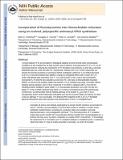| dc.contributor.author | Young, Douglas D. | |
| dc.contributor.author | Schultz, Peter G. | |
| dc.contributor.author | Stubbe, JoAnne | |
| dc.contributor.author | Minnihan, Ellen Catherine | |
| dc.date.accessioned | 2013-11-22T16:26:52Z | |
| dc.date.available | 2013-11-22T16:26:52Z | |
| dc.date.issued | 2011-09 | |
| dc.date.submitted | 2011-08 | |
| dc.identifier.issn | 0002-7863 | |
| dc.identifier.issn | 1520-5126 | |
| dc.identifier.uri | http://hdl.handle.net/1721.1/82547 | |
| dc.description.abstract | Tyrosyl radicals (Y·s) are prevalent in biological catalysis and are formed under physiological conditions by the coupled loss of both a proton and an electron. Fluorotyrosines (F[subscript n]Ys, n = 1–4) are promising tools for studying the mechanism of Y· formation and reactivity, as their pK[subscript a] values and peak potentials span four units and 300 mV, respectively, between pH 6 and 10. In this manuscript, we present the directed evolution of aminoacyl-tRNA synthetases (aaRSs) for 2,3,5-trifluorotyrosine (2,3,5-F[subscript 3]Y) and demonstrate their ability to charge an orthogonal tRNA with a series of F[subscript n]Ys while maintaining high specificity over Y. An evolved aaRS is then used to incorporate F[subscript n]Ys site-specifically into the two subunits (α2 and β2) of Escherichia coli class Ia ribonucleotide reductase (RNR), an enzyme that employs stable and transient Y·s to mediate long-range, reversible radical hopping during catalysis. Each of four conserved Ys in RNR is replaced with F[subscript n]Y(s), and the resulting proteins are isolated in good yields. F[subscript n]Ys incorporated at position 122 of β2, the site of a stable Y· in wild-type RNR, generate long-lived F[subscript n]Y·s that are characterized by electron paramagnetic resonance (EPR) spectroscopy. Furthermore, we demonstrate that the radical pathway in the mutant Y[subscript 122](2,3,5)F[subscript 3]Y-β2 is energetically and/or conformationally modulated in such a way that the enzyme retains its activity but a new on-pathway Y· can accumulate. The distinct EPR properties of the 2,3,5-F[subscript 3]Y· facilitate spectral subtractions that make detection and identification of new Y·s straightforward. | en_US |
| dc.description.sponsorship | National Institutes of Health (U.S.) (Grant GM29595) | en_US |
| dc.language.iso | en_US | |
| dc.publisher | American Chemical Society (ACS) | en_US |
| dc.relation.isversionof | http://dx.doi.org/10.1021/ja207719f | en_US |
| dc.rights | Article is made available in accordance with the publisher's policy and may be subject to US copyright law. Please refer to the publisher's site for terms of use. | en_US |
| dc.source | PMC | en_US |
| dc.title | Incorporation of Fluorotyrosines into Ribonucleotide Reductase Using an Evolved, Polyspecific Aminoacyl-tRNA Synthetase | en_US |
| dc.type | Article | en_US |
| dc.identifier.citation | Minnihan, Ellen C., Douglas D. Young, Peter G. Schultz, and JoAnne Stubbe. “Incorporation of Fluorotyrosines into Ribonucleotide Reductase Using an Evolved, Polyspecific Aminoacyl-tRNA Synthetase.” Journal of the American Chemical Society 133, no. 40 (October 12, 2011): 15942-15945. | en_US |
| dc.contributor.department | Massachusetts Institute of Technology. Department of Biology | en_US |
| dc.contributor.department | Massachusetts Institute of Technology. Department of Chemistry | en_US |
| dc.contributor.mitauthor | Minnihan, Ellen Catherine | en_US |
| dc.contributor.mitauthor | Stubbe, JoAnne | en_US |
| dc.relation.journal | Journal of the American Chemical Society | en_US |
| dc.eprint.version | Author's final manuscript | en_US |
| dc.type.uri | http://purl.org/eprint/type/JournalArticle | en_US |
| eprint.status | http://purl.org/eprint/status/PeerReviewed | en_US |
| dspace.orderedauthors | Minnihan, Ellen C.; Young, Douglas D.; Schultz, Peter G.; Stubbe, JoAnne | en_US |
| dc.identifier.orcid | https://orcid.org/0000-0001-8076-4489 | |
| mit.license | PUBLISHER_POLICY | en_US |
| mit.metadata.status | Complete | |
